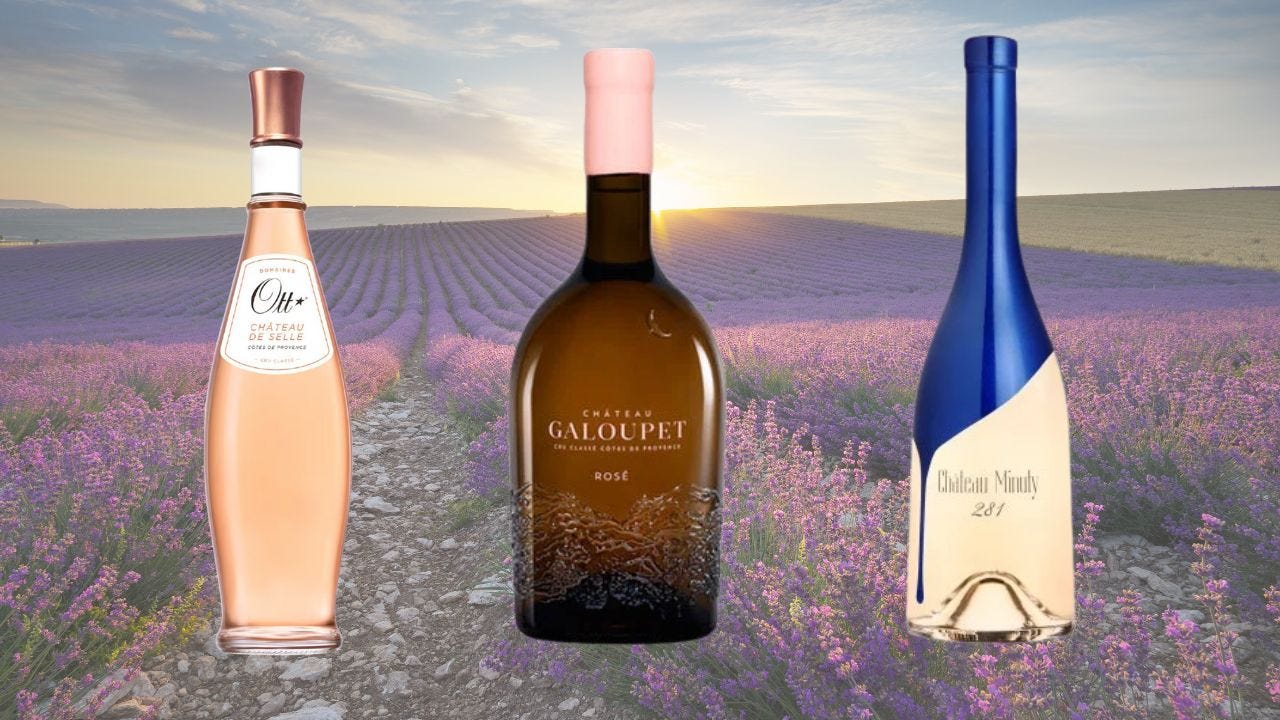Provence in southeastern France sets the benchmark for pale and pretty pinks with a characteristic saline tang. - but they are not all the same. Here’s everything you what you need to know about the nuances of Provençal rosé. Buckle up. It’s a juicy one!
Provence is famous for blends, especially its premium pink wines, which make up 90% of production. Only around 8% of wine here is red and under 4% is white, it’s clear to see that Provence’s power lies in its pink. We’ll cover white and reds another time but for now, let’s look at Provence through rosé tinted glasses.
Provençal Rosé: The Key Grapes
There are four grapes that make the most noise in Provençal pink blends with some other varieties permitted but not used as much, generally. Together they’re like members of a band and that band is the beach Boys!
Grenache - The leader. The Brian Wilson! Juicy, red fruit and complexity.
Cinsault - Delicate & floral with fresh strawberry notes.
Syrah - Colour, spice and power!
Mourvèdre - Earthy, brooding dark fruit.
One grape to keep an ear out for in Provence in Tibouren. Currently, it’s largely one of the supporting grapes but some producers like Chateau Galoupet are nurturing it. Tibouren is known for its subtle but reliable complexity, adding a lovely herbaceous Mediterranean garrigue note to a blend. This is the Al Jardine of the blend.
There are some other grapes too, which are like the supporting members (such as Brian Johnston and David Marks were): Carignan and Vermentino are largely used to add balance and complexity as well as adding nuance to creating styles like harmonies that are unique to each producer.
FUN FACT!
Domaines Ott in Provence made the first skittle shaped bottle that sparked a trend in the area but not only that, it was said that it was because of their premium white wines made from Sémillon and Rolle (aka Vermentino) at their Clos Mireille estate that people took a punt on the pinks they made a small amount of - and sort of sold on the side. People quite liked the pinks, to say the least and the rest is history.
SIPS SAFARI: Provence Pinks
Provence is not just one homogeneous area; there are tones of regions and sub regions, though they are often lumped together on wine lists. However, there are three areas that are the most famous with five more niche ones to know about - and each brings specific qualities. Start your Sips Safari with the big three and don’t forget to try their trade up, gastronomic styles too, which often have some oak and lees ageing for creaminess.
Côtes de Provence AOC
This is the largest and most famous appellation responsible for around 75% of wines. It’s pretty big and has now has its own official ‘crus’, where each cru is defined by stricter rules on yields, permitted grape varieties, winemaking and vineyard area, recognising them as the “best bits” of Côtes de Provence. Here are the cru:
Côtes de Provence La Londe - Elegant, citrusy and floral, from coastal vineyards with a sea-breeze freshness.
Côtes de Provence Fréjus - Peppery, saline and distinctive, from volcanic soils with garrigue shrubs.
Côtes de Provence Pierrefeu - Full-bodied, spicy and ripe, from more inland valleys. Thee have softer lines and a more generous body.
Côtes de Provence Notre-Dame des Anges - Aromatic, balanced and floral, from vineyards in the central, forested heartland of Provence.
Côtes de Provence Sainte-Victoire (newly elevated!) - Lean, structured and mineral, from rocky, sun-drenched slopes. These are classical, tight and ageworthy.
Coteaux d’Aix-en-Provence AOC
The second-largest rosé-producing region after Côtes de Provence is Coteaux d’Aix-en-Provence, located to the west of Aix-en-Provence. These rosés often show an extra touch of spice and herbal aromas, typical of the garrigue ie. those aromatic, wild French herbs.
Coteaux Varois en Provence AOC
A much smaller appellation, located in the heart of Provence around Brignoles is Coteaux Varois en Provence. This region produces elegant, fresh peachy rosés with more of a zesty, citrusy character.
The Niche Appellations
As I mentioned there are other smaller sub appellations to explore with Provencal pink but it helps to get a feel for the big three first. The niche ones to try however are:
Bandol AOC, which is more famous for its Mourvèdre-based reds but its pinks are Mourvedre heavy too and with more weight and meatiness to them. This is the best known of this particular bunch, but you might also want to try wines from the teeny
Les Baux-de-Provence AOC, Cassis AOC, Palette AOC and Bellet AOC.
QUALITY FACT! Cru Classé de Provence
Although Provence doesn’t have an official Premier Cru or Grand Cru system, it does have a historical classification called Cru Classé. This was introduced in 1955, identifying 23 estates in Provence, mostly within the Côtes de Provence AOC, that were recognised for their quality, history, and terroir. Examples of Cru Classé estates you may know include Domaines Ott, Château Minuty, and Château Galoupet.
Want some recommendations? I’ll send a newsletter at the end of this week with an article on my website helenasips.com. In the meantime, make sure you are subscribed and if you want more in depth wine knowledge, sign up for my bite-sized, video wine course!





